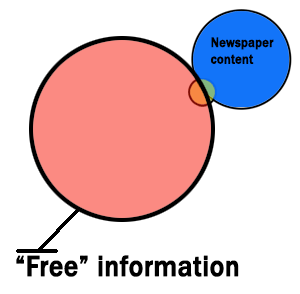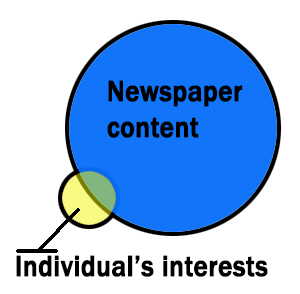Why news is a fungible commodity, and why that matters
News is a fungible commodity. That is to say: News of the sort provided by daily metro newspapers consists in large part of information that readers can easily replace with similar or identical information obtained elsewhere. This has dire implications for many of the models for saving newspapers.
Let’s look at a common counterargument: Newspapers provide news that isn’t fungible. No one else can provide what they do.
The first diagram here illustrates the nature of this argument. The big blue circle is all the content in, say, a week’s worth of newspapers. The smaller yellow circle, information that a particular potential reader is actually interested in. Pre-Internet, we could pretend that the yellow circle was much larger and fit almost entirely within the blue one. Readership surveys, flawed as they were, did hint that such wasn’t the case. But website statistics these days make it very clear that each individual reader generally reads only a small percentage of the content produced in an average day. So the relationship of the yellow circle to the blue one in this diagram is fairly generous, I’d say.
The overlap between the yellow and blue circles is that portion of an individual’s interests that are served by a given week’s newspaper content. Blue and yellow make green: This is where the money value of a newspaper is, for each particular reader.
And this is where one part of the argument is: How far should that yellow circle be pushed into the blue? Remember, this is about one particular newspaper and one particular reader. It’s easy, when you’re working for a newspaper, to believe that there is a huge appetite for the news meal you serve each day. I am about as steeped in newspapers as you can get: Our family always got at least two papers a day when I was growing up; I went to journalism school and worked at papers for more than three decades. Yet since I left about a month ago, my interest in what’s in the local paper has dropped dramatically. I may glance at the headlines in print or online once or twice a day, but seldom delve further.
It’s not that I don’t care about news in general. But most of what’s in the local paper isn’t of interest to me. Items about cities and towns I don’t live in? One more analysis of the government shutdown? Reviews of restaurants a long drive away? Sixteen articles about a sports team I’m not really into? Eh. If I want to read about the government shutdown, I’ll generally look to sites with wider D.C. expertise or more biting opinions. And that’s even though my local paper has an exceptionally mighty, albeit tiny, D.C. staff. Sure, there are other readers who will read every one of those 16 sports stories. On the other hand, most of them will probably be even less interested than I am in the paper’s take on the shutdown.
We’ve now gotten to the other big part of the argument: Whether the news the local paper does provide can be replaced easily.
 In the second diagram, I’ve shrunk down the original to make room for another circle. The red one represents information that’s available for free — at least perceived as free (i.e., not counting ISP charges or such) — outside an individual paper’s walls. It’s the biggest circle of all, and it’s been growing not just since the Internet, but since radio was invented. That’s why I don’t put much weight on the argument that the demand for news has gone down; I think the ratio and overlap of yellow to blue has been fairly constant for decades. What’s expanded is the supply.
In the second diagram, I’ve shrunk down the original to make room for another circle. The red one represents information that’s available for free — at least perceived as free (i.e., not counting ISP charges or such) — outside an individual paper’s walls. It’s the biggest circle of all, and it’s been growing not just since the Internet, but since radio was invented. That’s why I don’t put much weight on the argument that the demand for news has gone down; I think the ratio and overlap of yellow to blue has been fairly constant for decades. What’s expanded is the supply.
I’ve drawn the circles in this orientation to skip around one of the less persuasive arguments of newspaper defenders: That news obtained from other sources doesn’t count if it ultimately traces back to a newspaper report. That is, if what I read on a blog or Twitter or see on TV was first reported by, or even copied from, a newspaper account, then that’s not a true alternative for the reader. From a business standpoint, that’s a silly argument. As a consumer, I don’t care who first reported the story. And I may even put more value on the more concise, more pointed versions I can find elsewhere than on the longer traditional newspaper account. But let’s give the newspapers that point: Let’s say that almost all the content in our hypothetical week’s worth of newspapers was originally reported by that newspaper. Thus, most of the blue circle lies outside the red circle of news available elsewhere for free.
Even so, the most ardent newspaper advocate would have to agree that there is some overlap. And that means trimming that fingernail’s width of green, irreproducible value even narrower.
Add in the sheer amount of information of any kind available for free nowadays — a ratio of free to paid much bigger than this diagram can show. Even if most of that info is of little or no interest to a particular individual, its existence makes a difference to her perception of value. No matter how much loyalty I may have to, say, a local TV reviewer, doesn’t the ability to read similar reviews from a hundred different people for free online reduce my hometown reviewer’s value to almost nil?
This is the ultimate problem: If newspapers try to charge more for what they’re already providing, they risk increasing the allure of free alternatives, even if that involves accepting lower quality. If they try to increase the amount of information they provide, the likely increase in the value perceived by any particular potential customer may not be very large. If they choose to go free online, they may have many more green slivers available — but they have to then figure out a way other than subscriptions to convert those to cash.
A traditional way to escape the supply-and-demand squeeze when selling a fungible commodity is to develop branding, to offer “unique selling propositions.” This is where something like the Dallas Morning News’ offer of a “premium” online product identical in content to its free website comes in. (Although I have to say that in practice, this looks more like just another attempt to prop up print circulation with bundling.) My former colleague Damon Sims and I used to talk about ease of use as a USP (although we didn’t use that term).
The DMN’s “premium” site design has gotten some jabs.
All Dallas Morning News articles: free! All articles laid out onto rectangles with photo backgrounds: $143/year http://t.co/U5ZZWk3c4e
— Joshua Benton (@jbenton) September 30, 2013
But everyone who’s tried to negotiate news websites knows that as the amount of information available on a given site rises and the attempts to extract money via ads rise, the ability to find what you want, get it to load on your screen and read it decline. A better user experience could indeed have value. And while most of the money spent on increasing content would be wasted on any one particular user, every dollar put into better interfaces is likely to pay off in perceived value from most if not all potential customers.
Whether the DMN’s experiment will go far enough in providing a USP to make its premium site a cash value to users will take a little time at least to figure out. I think premium has to mean far more than faster loading of article pages and fewer ads.
What I don’t think will work for anyone in the long run is denying that newspapers’ product is a fungible commodity in a market swamped by supply. Any successful model will have to start from that base.

